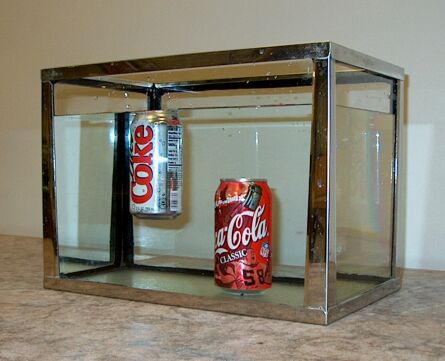
A video of this demonstration is available at this link.
Different flavors of Coke® have different densities.
This demonstration is based on Archimedes’ principle, which is illustrated by the next demonstration, 36.36 -- Archimedes’ principle, and which states that a body wholly or partly immersed in a fluid experiences an upwards force, or a buoyant force, equal to the weight of the fluid it displaces. If the immersed object is denser than the fluid, gravity exceeds the buoyant force, and the object sinks. If the object is less dense than the fluid, the object floats to a level where the buoyant force balances gravity. The idea behind this demonstration is that regular Coca-Cola contains 39 g of sugar per 355 ml soda, but, because the sweetener in Diet Coke is so much sweeter than sugar, there is much less of it in the Diet Coke than there is sugar in regular Coke. Diet Coke should therefore be less dense than regular Coke. The total volume of a Coke can (of either variety) is 380 cm3. If the corresponding volume of water weighs just slightly more than the can does, then if we immerse the can in the tank of water, it floats. In other words, the mass of the can must be somewhat less than (1.0 g/cm3)(380 cm3) = 380 g. The can of Diet Coke shown above has a mass of about 370 g, as does a second spare can. Its overall density is 370 g/380 cm3, or 0.97 g/cm3. This 3% difference in density as compared to that of water is enough to allow the can to float as in the photograph above.
Each can of regular Coke currently on hand has a mass of about 384 g. The difference that this represents with respect to the density of water – about 1.0% – is enough to sink the can. (Actually, if the density of the can plus contents is the slightest bit greater than that of water, the can will sink.)
If the fluid in the tank were dense enough, both cans would float. To this end, this demonstration includes a beaker of salt and a large stirring rod. By adding salt to the tank, you can increase the density of the water (which is now salt water). A 1.5% (wt/wt) salt solution has a density of 1.0107 g/cm3. For the 15-liter tank, this would be approximately 225 g of salt. So any salt concentration greater than this should be enough to raise the can of regular Coke. To be safe, the beaker contains about 275 grams of salt, which is more than enough to raise the heaviest Coke can listed above. To dissolve all the salt, you need to stir the water rather vigorously, for which you can use the large stirring rod.
A humorous note:
After one class session that included this demonstration, I found the Diet Coke floating in caramel-colored water, and the empty Coke can beside the tank. A student had asked if pouring the regular Coke into the water might raise the can of Diet Coke above where it had been floating. Pouring 355 ml of Coke into the 15-liter tank diluted it by a factor of 45, so any change it made to the density of the water would have been minuscule. At the time, for some reason I had no spare cans of Coke. So I bought a 12-pack of Coke, and brought in several cans at random. The next time someone requested this demonstration, I came in at the end of class to find, to my chagrin (and, I’m sure, the professor’s as well), both the Diet Coke and regular Coke cans floating! (He had not added the salt to the tank.) I then tried all the cans in the 12-pack, and I found that about half of them sank, and half of them floated.
The soda cans are sold as containing 12 ounces, or 355 ml, of liquid. This leaves just under 25 ml head space. The can itself is about 13 g. The 39 g of sugar in 355 ml Coke is about 11%. According to the tables in the 51st edition of the CRC Handbook of Chemistry and Physics, an 11% solution of either fructose or sucrose has a density of slightly greater than 1.04 g/ml (1.045 for fructose and 1.044 for sucrose). We may reasonably expect that the sugars in Coke should bring its density near this. Dissolved carbon dioxide, in both Diet and regular Coke, probably also changes the density. If we use a density of 1.045 g/ml for the Coke, 355 ml has a mass of 371 g. Adding 13 g for the can brings this to 384 g, for an overall density of 1.01 g/ml, enough to sink the can. (Any mass over about 380 g will sink the can, as noted above.) As the measured masses of the Coke cans indicate, there is some variation in either the density of the Coca-Cola itself, or the volume delivered to each can. Also, the mass of the can may vary somewhat (the ones I measured were somewhere between 12 and 13 g), and it is also possible that the overall size of the can could vary slightly. Thus, it is possible – even likely – to find cans of regular Coke that are the same density as water or less, and that float as a result.